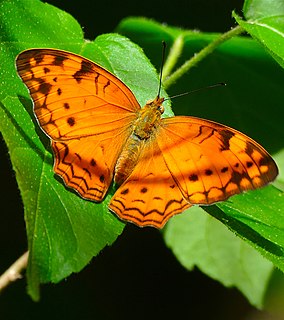Alaena margaritacea, the Wolkberg Zulu, is a species of Zulu butterfly in the family Lycaenidae. It is endemic to South Africa, where it is only known from grassy slopes adjoining Afromontane forest in the Haenertsburg area of Limpopo near the Wolkberg mountain range.
Lepidochrysops lotana, the Lotana blue, is a species of butterfly in the family Lycaenidae. It is endemic to South Africa, where it is only known from two localities in the Limpopo province, the western slope of the Ysterberg and from Moria to Serala Forest in the Wolkberg area.
Dingana dingana, or Dingaan's widow, is a butterfly of the family Nymphalidae. It is found in the KwaZulu-Natal midfields from the Drakensberg foothills to the Mooi River.
Dingana angusta, the narrow-banded widow, is a butterfly of the family Nymphalidae. It is found in grasslands the eastern highlands from northern Eswatini to Mpumalanga and the Limpopo Province.
Dingana fraterna, the Stoffberg widow, is a butterfly of the family Nymphalidae. It is only known from one hillside to the south-west of the Stoffberg in the Mpumalanga province.
Dingana jerinae, or Jerine's widow, is a butterfly of the family Nymphalidae. It is only known from the upper southern scree slopes of the Kransberg in Limpopo, South Africa.
Dingana alticola, the red-banded widow, is a butterfly of the family Nymphalidae. It is only known from high altitude grassland in the Steenkampsberg area in the Mpumalanga province.

Dingana alaedeus, the Wakkerstroom widow, is a butterfly of the family Nymphalidae. It is only known from high altitude grassland at about 2,000 meters. It has a short flying period in summer. The specific name means “god of the wing” in Latin.
Dingana bowkeri, or Bowker's widow, is a butterfly of the family Nymphalidae. It is found in Lesotho, South Africa, in the Eastern Cape and Richmond and Cradock in the Cape Province.
Dingana clarki, or Clark's widow, is a butterfly of the family Nymphalidae. It is found in South Africa.
Dingana kammanassiensis, the Kammanassie widow, is a butterfly of the family Nymphalidae. It is only known from the slopes of the Kammanassie massif near Uniondale in South Africa.
Coenyra rufiplaga, the Secucuni shadefly, is a butterfly of the family Nymphalidae. It is found in South Africa, it is widespread in Limpopo from the Waterberg Biosphere and Strydpoortberg to the Wolkberg.
Pseudonympha magoides, the false silver-bottom brown, is a butterfly of the family Nymphalidae. It is found in South Africa, from the Western Cape to the Eastern Cape, along the Drakensberg foothills into Lesotho, KwaZulu-Natal, Eswatini, Mpumalanga, north to the Wolkberg. It is also found in Free State and Gauteng.
Sarangesa ruona, the Ruona elfin, is a butterfly of the family Hesperiidae. It is found in thickly wooded savanna and lowland forest in the Maputaland area of KwaZulu-Natal and the north-western parts of the Limpopo Province lowlands east of the Wolkberg and north and east of the Soutpansberg. It is also present in Zimbabwe.

Spialia secessus, the Wolkberg sandman, is a butterfly of the family Hesperiidae. It is found in high savannah and montane grasslands from Eswatini to northern KwaZulu-Natal, the eastern part of the Limpopo Province and Mpumalanga. It is also present in Zimbabwe. It is named after the Wolkberg range.
Acraea alalonga, the long-winged orange acraea, is a butterfly of the family Nymphalidae. It is found in montane grassland from the Drakensberg and midlands in KwaZulu-Natal, north into Mpumalanga and the Wolkberg in Limpopo.

Lachnoptera ayresii, the eastern blotched leopard, is a butterfly of the family Nymphalidae. It is found in Afromontane and riverine forest from Port St. Johns in the Eastern Cape and then along the escarpment to the midlands of KwaZulu-Natal, Eswatini, Mpumalanga and the Wolkberg in Limpopo, north to Zimbabwe and Mozambique.

Iolaus silarus, the straight-line sapphire, is a butterfly of the family Lycaenidae. The species was first described by Hamilton Herbert Druce in 1885. It is found in Mozambique, Zimbabwe, Botswana, Namibia, Malawi, Zambia, southern Zaire, Tanzania, south-western Kenya and South Africa. In South Africa it is found in wooded savannah in northern KwaZulu-Natal and in savannah from Eswatini to Mpumalanga, Limpopo and North West. It is also present in Afromontane forest on the Wolkberg and the northern Drakensberg.
Aloeides stevensoni, the Stevenson's copper, is a butterfly of the family Lycaenidae. It is found in South Africa, where it is restricted to montane sourveld grassland on the Wolkberg near Haenertsburg.

The Wolkberg is a mountain range in Tzaneen, Limpopo Province, South Africa. It is a northern termination and a subrange of the Drakensberg mountain range which lines up from Eastern Cape, Lesotho, Kwazulu Natal and Mpumalanga. At 2200 m (7200 ft) above sea level, it is the highest mountain range in Limpopo, together with the Iron crown mountain. Its Meteorological significance is that it brings along cold fronts and is a source of cold winters throughout the Limpopo province, the cold front gets transferred from greater Drakensberg mountains in Kwazulu Natal all the way to the Wolkberg. Without the Wolkberg, Limpopo will not experience cold winters at all. The range extends for about 30 km (19 mi) in a NW/SE direction north of Sekhukhuneland. The nearest towns are Haenertsburg and Tzaneen.




